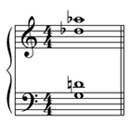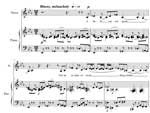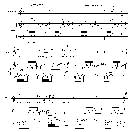Aeschylean Structure and Text in New Opera: The Oresteia Project
by Andrew Earle Simpson
B. T. Rome School of Music, The Catholic University of America
and Sarah Brown Ferrario
Department of Classics, Princeton University
Production notes
Agamemnon, the first opera of The Oresteia Project, received a partially staged workshop production accompanied by chamber ensemble at The Catholic University of America, Washington, DC, in 2001, and a fully staged university premiere in 2003, accompanied by full orchestra. Both productions involved the use of professional dancers (choreographed by Douglas Yeuell and Miya Hisaka, respectively). The recordings and photos incorporated into this article are from the 2003 full-stage university production. Additional information, including personnel lists, full streaming audio and video of all three 2003 performances, and a complete libretto, is available on Agamemnon's website.
The Libation Bearers, the second opera of The Oresteia Project, received a concert workshop production accompanied by chamber ensemble at The Catholic University of America, Washington, DC, in 2004. The performance was enhanced by the display of black-and-white film images (http://www.geocities.com/libationbearersmovie2/) conceived, produced, and directed by Nicholas Ferrario especially for the production. The images incorporated into this article are captured stills from this film, and the recordings are also from this university workshop. Additional information, including personnel lists, full streaming audio and video of both 2004 performances, and a complete libretto, is available on The Libation Bearers' website.
The large corpus of extant operas based upon Greek tragedy includes some of the most acclaimed masterworks of the genre: Marc-Antoine Charpentier’s Medée (1693), Christoph Willibald von Gluck’s Iphigénie en Aulide (1774), Hector Berlioz’ Les Troyens (1863),Richard Strauss’ Elektra (1909), Igor Stravinsky’s Oedipus Rex (1927). All of these works, and the vast majority of their fellows, alter (in manners other than excision or translation) the structure and texts of their ancient sources to a greater or lesser degree. These changes, which significantly affect the staged realizations of the dramas, frequently appear to have been made to accommodate contemporary musico-theatrical theories, practices, or tastes: for example, the lieto fine of M. F. L. G. B. du Roullet’s libretto for Gluck’s Iphigénie en Aulide displays the late-eighteenth century propensity for happy endings, but has no relationship to any of the known possibilities for the conclusion of the eponymous Euripides play. Other alterations seem to have been politically motivated: the vast prologue of Thomas Corneille’s libretto for Charpentier’s Medée not only supplants Euripides’ separate introduction by the Nurse, but also presents an entire opera-ballet pageant glorifying Louis XIV, the ‘Sun King.’
Although it is by no means accurate to characterize twentieth-century operatic treatments of Greek tragedy as the most venturesome yet (witness, for example, Simon-Joseph Pellegrin’s libretto for Jean-Philippe Rameau’s Hippolyte et Aricie (1733) which adds to Euripides’ Hippolytus not only a journey through Hades for Theseus but also, drawing directly on the example of Racine's Phèdre, a young lover for the formerly virginal hero to marry), it is probably correct to view them as displaying the widest possible variety of adaptation efforts. Hugo von Hofmannsthal’s libretto for Strauss’ Elektra betrays Freudian and expressionistic influences not only in its psychological explorations of parent-child and sibling-sibling relationships, but also in its fascination with naturalistic human emotion. Stravinsky’s Oedipus Rex, on the other hand, adopts a ritualistic, Brechtian detachment in its presentation of Sophocles’ tragedy. Billed as an ‘opera-oratorio,’ the work seeks to create such a level of emotional divorce from its subject matter that it employs a deadpan speaking narrator to summarize scenes in the vernacular before they are presented musically, in deliberately artificial and occasionally incorrect Latin translated 'backwards' by Jean Daniélou from a French libretto by Jean Cocteau. More recent operatic and para-operatic engagements with Greek tragedy and myth have participated in the postmodernist theatrical tradition, challenging established concepts of genre, dramatic structure, characterization, and plot: Iannis Xenakis’ Oresteia (1965-6, rev. 1969, 1987, 1989), Harrison Birtwistle’s The Mask of Orpheus (1986), and Liza Lim’s Oresteia: A Memory-Theater (Opera) in Seven Parts (1991-93) transform their ancient source material through the innovative use of dance, technology, and even puppetry and acrobatics.
In this rich artistic context (of which only a very small sample has been referenced here), it might initially appear that any new operatic treatment of a Greek tragedy in the twenty-first century would only be adding another voice, however appealing, to an ever-growing chorus. The ongoing search of creative artists for fresh and original approaches to tragic themes, particularly in more recent decades, means that new productions are increasingly concerned with coherently defining their intentions and their interpretations. In the case of The Oresteia Project, the distinctive approach to Aeschylus employed by the two operas completed to date was invited by the inherent dramatic qualities of the text itself. Rather than altering the structure, plot, or content of the ancient plays, The Oresteia Project preserves these elements to the greatest extent possible under modern operatic circumstances, maintaining the order and proportions of major scenic elements while employing an English libretto sourced exclusively from the ancient Greek.
 |
Plate 1 The Libation Bearers film: The grave of Agamemnon.
Photographed by Nicholas Ferrario.
This artistic stance, loosely referenced by members of the Project as ‘faithfulness’ to the text of the Oresteia (the result, of course, of generations of scholarly editing; the libretto was created from the 1972 Oxford Classical Text, hereafter “OCT,” of Sir Denys Page), demanded careful attention to the many excisions, or ‘cuts,’ which were necessary if the two plays which have been adapted thus far were to become workable one-act operas, the Project’s aim. Because more time is generally required to sing a given line, in any manner, than to speak it, the ancient texts had to be shortened by approximately one-half to two-thirds if the desired timings were to be accommodated. As such, the completed operas of The Oresteia Project, in order to conform to the goal of representing the ebb and flow of tension which is generated by Aeschylus’ tragic plots, essentially had to represent Agamemnon’s and The Libation Bearers’ scenic structures in miniature, preserving sectional proportions while presenting significant content as efficiently as possible.
What to cut was actually decided by determining what to maintain. Above all else, no scenes, characters, or choruses were eliminated or relocated, and nearly all speeches were represented. Beyond this, utterances essential to the introduction of characters and circumstances or to the progression of the plot were the first to be included. At the next layer of consideration, a selection of the most significant and visually arresting chains of imagery employed by Aeschylus were consistently re-incorporated throughout in order to demonstrate the poet’s rich and tapestried language. Finally, the resulting shortened speeches, dialogues, and choruses were examined for their relative lengths and adjusted in order to ensure that they were viable representations of the comparative spaces occupied in the Aeschylean original (this latter process continued intermittently throughout the translation and composition phases of both operas).
At this stage, the libretti were translated from Greek to English. Several considerations governed this process. Firstly, no English words were selected which could not be legitimately understood as being derived from the Greek, with the exception of the repetition of proper names and pronoun antecedents; no material was interpolated. Secondly, ‘singable’ language was employed throughout, with shorter words preferenced over longer ones, and open vowels over closed. Sentences were crafted with the technical concerns of English vocal diction in mind. Finally, the poetry of a given speech, section, or scene was determined in conjunction with the musical plans of the composer; for example, driving, rhythmic lines were created for anticipated moments of high tension, and textual patterns based on numbers of syllables were designed for passages which demanded tight structure, such as choruses.
The organization of the musical scores was determined from the beginning by the viable analogies which could be drawn between the internal textual forms of Greek tragedy and the component elements of modern opera. Speeches became arias, passages of stichomythia were rendered as recitatives, and choruses maintained their identities as ensemble scenes; the results were essentially ‘number operas,’ in which musical sections were clearly delineated and distinctively rendered. Although the structure and content of both Agamemnon (1999-2002) and The Libation Bearers (2001-04) were designed to be exclusively Aeschylean under the terms described above, the melodic and harmonic language of both works deliberately avoids any overt attempts to reproduce or evoke ancient Greek performance practices. The Oresteia Project’s operas are fully contemporary in their musical idiom and designed in accordance with twenty-first century staging conventions. They are intended to represent a symbiotic relationship between the uniquely expressive medium of modern opera and the unparalleled dramatic power of Aeschylean tragedy, with each genre’s inherent strengths drawing upon and being magnified by the other’s in turn.
 |
Plate 2 Agamemnon, Scene 2, Chorus I: Dancers re-enact the sacrifice of Iphigeneia.
Photographed by Gary Pierpoint (The Catholic University of America).
A good example of this intimate connection is the employment within the two completed operas of ‘musical characterization’ and leitmotifs, which function in context very much like the chains of imagery which Aeschylus uses to unify his dramas. Like the Oresteia’s references to (e.g.) blood, animals, and sacrifice, the characteristic musics and leitmotifs recur in varied guises throughout the score to highlight significant themes. The most important motive in the operatic Agamemnon is the first chord of the work:
Score Example 1
Audio Example 1: First chord
This ‘death chord,’ which represents the murder of Agamemnon, functions as both predictor and remembrance of this event throughout the first opera. It is also used to indicate insincerity, as in the opera’s Scene 4, when Klytemnestra dismisses the Herald to return to Agamemnon with the words, “Let him come as quickly as he may, the king whose city longs for him” (translated from the OCT of Agamemnon, line 605), while simultaneously the chord in the orchestra indicates the queen’s true intentions. The ‘death-chord’ also makes a prominent reappearance in the final chorus of The Libation Bearers opera, when the serving-women recollect the king’s slaying (“Second came the kingly sufferings, the lord of ships struck in his bath” = OCT Libation Bearers 1070-2). As the chord sounds in the orchestra, the melody of the second choral phrase recollects Klytemnestra’s main leitmotif:
Score Example 2
Audio Example 2: Klytemnestra's main motive
First heard in the Watchman’s Scene 1 of the operatic Agamemnon on the words “We work the will of a woman of manly heart” ( = OCT Ag. 10-11), Klytemnestra’s motive recurs frequently throughout both completed operas. Its structure and content are suggestive of the ‘musical characterization’ which Klytemnestra has and will receive throughout the operatic trilogy: her music is highly chromatic, ornamented, virtuosic, and rhythmically complex, with a wide vocal range (over two octaves), as witnessed in e.g. her opening aria “Troy is fallen” (Agamemnon, Scene 3) or her false lament over the news of Orestes’ death (The Libation Bearers, Scene 5). The texts of these two passages are as follows:
'Troy is fallen' (Agamemnon, Scene 3)
Klytemnestra ( = OCT Ag. 320, 324-9, 334-5, 337, 343-4, 346-7, 349-50, 267)
Troy is fallen, Troy is taken,
Cries of victor, cries of vanquished
Sound throughout the burning town.Trojans hold the lifeless bodies
Of their fathers, husbands, sons,
Curse their fate from shackled throats.Starving soldiers after battle
Break into the city stores,
Eat what chance or fate may bring.Tonight Greeks sleep in Trojan beds,
No watchful guards are needed now
For houses taken by the spear.MBut the Greeks still need a clear way home.
They must respect the Trojan shrines.May grasping greed not harm the Greeks,
The captured not become the conquerors,
And may our men come safely home with speed.Yet, something may await them here,
Some watchful vengeance from the dead,
Some sudden, unexpected . . .But may it not be so, my lords,
Since I prefer to praise the good.
The Greeks have taken Priam’s city!
'We are destroyed!' (The Libation Bearers, Scene 5)
Klytemnestra ( = OCT LB 691-6)
Ah! We are destroyed!
O curse upon this house,
so hard to grapple with,
how much you see!
From far off you attack with arrows that find all,
and strip me of what I love.
And now Orestes!
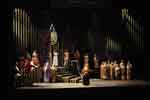 |
Plate 3 Agamemnon, Scene 5: Klytemnestra welcomes Agamemnon to his palace.
Photographed by Gary Pierpoint (The Catholic University of America).
Other characters are similarly represented by consistent motives and styles which help to emphasize their roles in the drama as expressed by the text: the Nurse of The Libation Bearers, a low mezzo-soprano, sings simple, bluesy music which emphasizes not only her sincerity in mourning Orestes but also her vernacular status:
Score Example 3
Audio Example 3: Nurse's aria
The text of this passage is as follows:
The Libation Bearers (The Libation Bearers, Scene 6)
Nurse ( = OCT LB 755-60)
A baby cannot speak, not an infant in swaddling clothes.
A baby cannot say,
' I am hungry', 'I am thirsty', 'You should change me.'
Its little belly makes its own rules.
I was a prophet for these things,
but I was also often wrong,
and I had to wash baby clothes--
nurse and laundress all at once.
 |
Plate 4
The Libation Bearers film: the sword of Orestes.
Photographed by Nicholas Ferrario.
Aegisthus in the musical version of Agamemnon is presented as a mock-heroic figure within the parameters of the operatic tradition: he becomes an effete parody of baroque opera seria, with an opening recitative accompanied by continuo (harpsichord and cello) and decorated with arpeggiated flourishes, and a scene translated throughout in rhymed English couplets. The Renaissance device of word-painting (representing verbal content in the structure of a musical line) also appears, e.g. in the descending melody setting the words “The gods gaze down from heaven on us men”:
Score Example 4
Audio Example 4: Recitative portion of Aegisthus' scene
The text of this passage is as follows:
'O light of day' (Agamemnon, Scene 8)
Aegisthus ( = OCT Ag. 1577-88)
O light of day that brings me sweet revenge!
The gods gaze down from heaven on us men,And watch our toils and suff’rings on the earth,
And now they must approve me in my mirth.The king lies wrapped in hellish, woven net,
A trap my vengeful, plotting hand has set.For Atreus, Agamemnon’s kingly sire,
Against his very brother did conspire.That brother was Thyestes, cast from home,
When he and Atreus both sought the throne.Thyestes was my father, clear to say,
Wand’ring in exile ‘till that fatal day,When home to his own hearth he came again,
And found a ‘safe’ return, most damned of men!
Individual sections of both completed operas also present especially rich opportunities for musical structures to interact with verbal ones. In the famous ‘tapestry-scene’ of Agamemnon (Scene 5 of the opera), for example, where Klytemnestra’s mastery of Agamemnon through speech prefigures the king’s physical destruction, the shift of power is emphasized in both libretto and score. The translated lines for Klytemnestra and Agamemnon contain precisely the same number of syllables at the beginning of their stichomythia, but as the conversation progresses, Klytemnestra’s vocabulary becomes more elaborate and her lines gain syllables, while the verbal space occupied by Agamemnon similarly diminishes. Musically, the increasing dominance of Klytemnestra is depicted through vocal register and dynamics: the conversation begins with the queen singing low in her range and piano, but her part gradually rises in both pitch and volume until she closes the exchange on a very high fortissimo line. Agamemnon starts the stichomythia at the powerful top of the baritone range and fortissimo, but his lines gradually drop, and he concludes piano, in a low voice. Additionally, Klytemnestra’s melodic material becomes increasingly complex throughout the exchange, while Agamemnon’s, always simpler than his wife’s, dwindles almost to a monotone.
Audio Example 5: Confrontation between Klytemnestra and Agamemnon
The text of this passage is as follows:
'Speak to me; tell me your judgment' (Agamemnon, Scene 5)
Klytemnestra ( = OCT Ag. 931-42)
Speak to me; tell me your judgment.Agamemnon
My judgment I shall not hold back.Klytemnestra
Would you do this in reverence for the gods?Agamemnon
If a soothsayer ordained it, I would.Klytemnestra
What would Priam do, if he were victor now?Agamemnon
I think that he would walk these tapestries.Klytemnestra
So do not fear, then, the blame of your people for this act.Agamemnon
But the people’s talk has power here.Klytemnestra
The lucky man inspires talk; others wish for what he has.Agamemnon
A woman should not argue!Klytemnestra
A conqueror should relent a little; that is just and right.Agamemnon
You want this so badly?
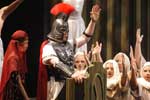 |
Plate 5
Agamemnon, Scene 5: Agamemnon arrives home from Troy, accompanied by Kassandra.
Photographed by Gary Pierpoint (The Catholic University of America).
In the ‘Kommos’ of The Libation Bearers (Scene 4 of the opera), Aeschylus’ complex poetical structure provokes a similarly tight, if new, organization of both text and music. In response to the relative lengths of the utterances of the characters (Orestes, Elektra, and the Chorus) as allotted by Aeschylus, the libretto mirrors the proportions of the ancient text, its exchanges accelerating (with the number of lines per entrance gradually diminishing) as the Kommos proceeds. As in the ancient drama, too, the Kommos as it stands in the opera comprises two large sections separated by a transition. In Aeschylus these consist of a (likely) sung poetic region and a (likely) spoken dialogic region in stichomythia separated by the longest choral passage in the scene; in the modern operatic version, the divisions are delineated by changes in tempo, rhythm, mood, and texture, and although their relative lengths are similar to those in Aeschylus, the sectional breaks do not occur in precisely the same locations.
The scene as a set-piece is evocative of classical Turkish music, beginning with a rhythmically free cadenza for the flute in a characteristic evocation of the Turkish ney, which also serves to highlight and delineate the opening of this new and significant section of the opera. The Kommos proper (where the text begins) opens in a steady 7/8 meter divided 2-3-2, which not only produces a sense of tension and instability as a result of the unequal beat lengths, but also pays a certain homage to both ancient Greek poetical rhythms (many of which are also asymmetrical) and modern Greek folk music, which shares this predilection. The tempo increases throughout the first half of the Kommos, until it reaches a central point, a slow moment which resembles again the opening flute cadenza, at the line “She cut him in pieces, too, she who buried him” ( = OCT LB 439-40). This is not where Aeschylus separates his segments; in the ancient text, there are some 25 more lines of sung material before the choral entrance which divides the two major sections of the scene. In the operatic version, however, the disturbing image of Agamemnon’s dismemberment, the most vivid concrete visual suggestion made by the libretto’s text, is selected for special emphasis. Sung slowly and in a low register by the Chorus Leader, this reference to the king’s mutilation in effect introduces a fresh motivation for the accelerating tempo and heightened mood of the second half of the (operatic) Kommos. This second passage is also in 7/8 time, but the division is now 2-2-3, which adds additional propulsion into the downbeat of each successive bar to heighten the building sense of tension. After the Kommos builds to a frenetic climax, as if waiting for the ghost of Agamemnon to appear (on Electra’s words, “Will you not raise up your beloved head?” = OCT LB 496, and Orestes’ “Send up Justice for those who love you!” = OCT LB 497), a final majestic, slow passage by Electra provides one final prayer before a fast coda in the orchestra closes the piece.
Audio Example 6: Second half of the Kommos
The text of this excerpt is as follows:
Kommos (The Libation Bearers, Scene 4)
Chorus ( = OCT LB 439-40)
She cut him in pieces, too--
she who buried him.Elektra (= OCT LB 444-6)
And I was far off,
in dishonor,
shut away in the depths
like a dog that she hated.Orestes (= OCT LB 456)
I call on you, father; be here with your children!Elektra (= OCT LB 457)
I cry out along with him, lamenting.Chorus (= OCT LB 458-9)
This group cries as one;
hear us and come to the light!
(OCT LB 459, in Greek, becomes a choral ostinato)Orestes (= OCT LB 479-80)
O father, who died as a king never should,
grant me the power of your house.Elektra (= OCT LB 481-2)
I ask that I may escape
after harming Aegisthus.Orestes (= OCT LB 491)
Remember the bath where you died, father!Elektra (= OCT LB 492)
Remember the trap they invented!Orestes (= OCT LB 493)
You were snared, father, in chains not of bronze.Elektra (= OCT LB 494)
Shamefully, in a crafty shroud!Orestes (= OCT LB 495)
Do these wrongs not move you, father?Elektra (= OCT LB 496)
Will you not raise up your beloved head?Orestes (= OCT LB 497)
Send up Justice for those who love you!Elektra (= OCT LB 500-2)
Hear this last cry, father.
Look on the children who sit by your tomb
and pity the tears of your daughter and son.
 |
Plate 6
The Libation Bearers film: Elektra pours libations on her father’s grave.
Photographed by Nicholas Ferrario.
In situating itself within the production and performance traditions of operatic works based upon Greek tragedy, then, The Oresteia Project returns to ancient dramatic structures and text as generative and guiding sources for its shape. While this particular approach to contemporary opera may be unique at this time, its more significant contribution, members of the Project believe, is that it demonstrates in performance the viability of the pacing, rhythm, organization, and original content of Aeschylean tragedy for the modern musical stage.
Work on the third and final opera of The Oresteia Project, The Furies, is currently in progress (spring 2005).

